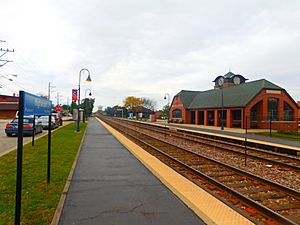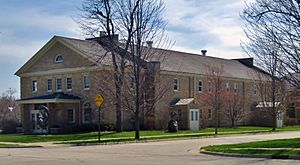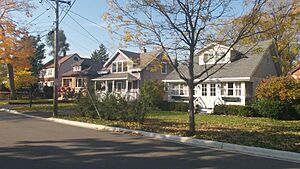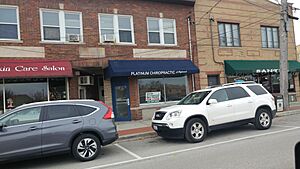Highwood, Illinois facts for kids
Quick facts for kids
Highwood, Illinois
|
|
|---|---|
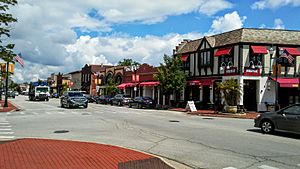
Downtown Highwood
|
|
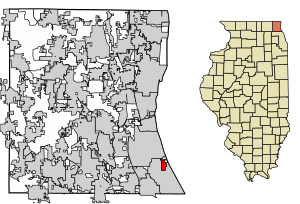
Location in Lake County, Illinois
|
|
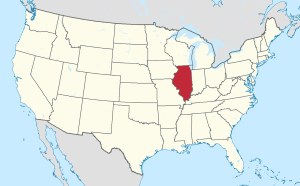
Location of Illinois in the United States
|
|
| Country | United States |
| State | Illinois |
| County | Lake |
| Area | |
| • Total | 0.72 sq mi (1.86 km2) |
| • Land | 0.72 sq mi (1.86 km2) |
| • Water | 0.00 sq mi (0.00 km2) |
| Population
(2020)
|
|
| • Total | 5,074 |
| • Density | 7,047.22/sq mi (2,721.29/km2) |
| Time zone | UTC-6 (CST) |
| • Summer (DST) | UTC-5 (CDT) |
| ZIP Code(s) |
60040
|
| Area code(s) | 847 |
| FIPS code | 17-34865 |
| Wikimedia Commons | Highwood, Illinois |
Highwood is a city in Illinois, located north of Chicago. It's known for its fun events, many restaurants, and lively atmosphere. In 2020, about 5,074 people lived there.
Contents
Highwood's Location and Landscape
Highwood is found in the southeastern part of Lake County. It sits on a high ridge, about 100 feet (30 m) above Lake Michigan.
The city covers about 0.71 square miles (1.84 km2) of land. Highwood is right next to Highland Park and Fort Sheridan. It's also south of the Fort Sheridan Forest Preserve, a great place for nature.
A Look at Highwood's Past
Early Days and Naming Highwood
The land where Highwood now stands was first home to the Potawatomi people. They gave up the land to the United States in 1833. The first non-Native American settlers arrived in 1846.
In 1851, Highwood became an important spot for the Chicago North Shore and Milwaukee Railroad. This railway ran alongside another one, now known as Metra's Union Pacific / North Line. A person named Thomas Curley suggested the name "High Woods." He chose this because the area was the highest point between Chicago and Milwaukee and was covered with many trees.
Fort Sheridan's Influence
In 1886, there was a lot of unrest in Chicago, including the Haymarket Riot. Business leaders in Chicago thought having a military base nearby would help keep things calm. So, in November 1887, they bought land in Highwood for a military camp. This camp became home to soldiers from the Sixth Infantry Regiment.
On February 27, 1888, the camp was officially named Fort Sheridan. It was named after General Philip Sheridan, who helped keep order after the Chicago Fire of 1871.
Growth and Challenges
Highwood offered many jobs and business chances. After the Chicago Fire, many people who lost their homes, along with new immigrants, moved to Highwood. The Chicago and Milwaukee Electric Railway also helped the city's economy grow.
Fort Sheridan became a center for entertainment for the town. In 1888, leaders even changed the town's name to the Village of Fort Sheridan. They wanted to benefit from the military base's fame. However, by 1894, the name was changed back to Highwood. Residents were frustrated because mail often got mixed up.
Highwood in the 1920s
In the 1920s, many immigrants from Northern Italy, especially from Modena, moved to Highwood. Many came from a coal mining town called Dalzell, Illinois. They were looking for new jobs and opportunities.
Highwood After World War II
During World War II, Fort Sheridan was an active training base for soldiers. After the war, Highwood saw another wave of new residents. Many immigrants came from Europe and Mexico. Since then, Highwood's businesses have continued to do well. The city is now a popular spot for dining and nightlife on the North Shore. Highwood often hosts festivals for its residents, like "Celebrate Highwood."
Getting Around Highwood
The main road to Highwood is U.S. Route 41. This highway connects Chicago to Milwaukee. You can also travel by train using Metra. Highwood has two Metra stations: Fort Sheridan and Highwood.
Nearby stations in Highland Park and Lake Forest are also on the Union Pacific North Line. This train line runs from Kenosha all the way to downtown Chicago at Ogilvie Transportation Center.
Pace also provides bus service on Route 472. This bus connects Highwood to Highland Park, Fort Sheridan, and other places.
For air travel, Highwood is about 22 miles (35 km) from O'Hare International Airport. It's also about 31 miles (50 km) from Midway International Airport.
Learning in Highwood
Highwood students attend schools in two main districts: North Shore School District 112 and Township High School District 113.
Most children in Highwood go to Oak Terrace School for kindergarten through fifth grade. Then they attend Northwood Junior High School for sixth through eighth grade. For high school, students go to Highland Park High School.
St. James School was a private Catholic school in Highwood. It closed in 2015 because it didn't have enough money or students.
Fun and Recreation
The Don Skrinar Recreation Center is a public place for fun activities. It's located near downtown Highwood. The city is also home to the Midwest Young Artists Conservatory and The Performer's School. The Fine Art Studio of ROTBLATT-AMRANY, owned by Julie Rotblatt Amrany, is in the old village of Fort Sheridan.
Highwood's Architecture
Highwood was settled in 1887. Much of its building happened before the big construction boom after World War II. This means Highwood has many older homes and businesses. These buildings show popular styles from that time, like neo-classical, Italianate, and arts and crafts bungalow styles. In the business area, you'll often see brick buildings with shops on the first floor and apartments above.
Highwood's Population
| Historical population | |||
|---|---|---|---|
| Census | Pop. | %± | |
| 1890 | 451 | — | |
| 1900 | 1,575 | 249.2% | |
| 1910 | 1,219 | −22.6% | |
| 1920 | 1,446 | 18.6% | |
| 1930 | 3,590 | 148.3% | |
| 1940 | 3,707 | 3.3% | |
| 1950 | 3,813 | 2.9% | |
| 1960 | 4,499 | 18.0% | |
| 1970 | 4,973 | 10.5% | |
| 1980 | 5,455 | 9.7% | |
| 1990 | 5,331 | −2.3% | |
| 2000 | 4,143 | −22.3% | |
| 2010 | 5,405 | 30.5% | |
| 2020 | 5,074 | −6.1% | |
| U.S. Decennial Census 2010 2020 |
|||
Highwood's Population in 2020
| Race / Ethnicity (NH = Non-Hispanic) | Pop 2000 | Pop 2010 | Pop 2020 | % 2010 | % 2010 | % 2020 |
|---|---|---|---|---|---|---|
| White alone (NH) | 2,347 | 2,079 | 2,071 | 56.65% | 38.46% | 40.82% |
| Black or African American alone (NH) | 79 | 72 | 110 | 1.91% | 1.33% | 2.17% |
| Native American or Alaska Native alone (NH) | 9 | 3 | 8 | 0.22% | 0.06% | 0.16% |
| Asian alone (NH) | 86 | 114 | 137 | 2.08% | 2.11% | 2.70% |
| Native Hawaiian or Pacific Islander alone (NH) | 2 | 1 | 0 | 0.05% | 0.02% | 0.00% |
| Other race alone (NH) | 9 | 16 | 23 | 0.22% | 0.30% | 0.45% |
| Mixed race or Multiracial (NH) | 27 | 46 | 127 | 0.65% | 0.85% | 2.50% |
| Hispanic or Latino (any race) | 1,584 | 3,074 | 2,598 | 38.23% | 56.87% | 51.20% |
| Total | 4,143 | 5,405 | 5,074 | 100.00% | 100.00% | 100.00% |
Highwood's Population in 2010
In 2010, Highwood had a population of 5,405 people. The average age of residents was 32.8 years old.
The racial makeup of the city included:
- 69.64% White (38.5% were non-Hispanic White)
- 1.54% Black or African American
- 2.24% Asian
- 0.31% Native American
- 0.02% Pacific Islander
- 22.92% of some other race
- 3.33% of two or more races
Also, 56.87% of the population was Hispanic or Latino (of any race).
Famous People from Highwood
- Frank Bernardi: A professional football player (1955–1960).
- Scott Drury: A member of the Illinois House of Representatives (2013–2019).
- Lowell B. Komie: A lawyer and writer.
- Francis Joseph Magner: A leader in the Catholic church, who served as Bishop of Marquette (1941–1947).
- Settimio Fernando "Terry" Terracina: The Light Heavy-Weight Boxing Champion of Italy from 1936 to 1939. He also owned local restaurants.
See also
 In Spanish: Highwood (Illinois) para niños
In Spanish: Highwood (Illinois) para niños


